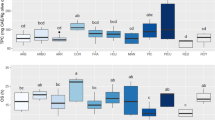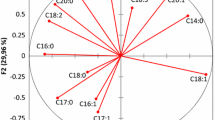Abstract
The present study reports the olive oil quality properties, namely free fatty acid, peroxides index, purity properties [fatty acid and triacylglycerol (TAG) composition], antioxidant compounds (total phenol, carotenoid and chlorophyll content) and oxidative stability. These analyses were performed for three rare cultivars grown in southern Tunisia (region of Tataouine). All the samples have presented good quality according to the international olive council norms. Nevertheless, there was a difference in many of the evaluated parameters as a function of ripening stages and cultivars. The oleic acid and linoleic acid amounts of olive oils increased with the ripening progress, with the highest rates were found in Fakhari cultivar. The most abundant triacylglycerols of olive oils were OOO, POO, LOO + PLnP, PLO + SLL and POP. Moreover, a general decrease (p < 0.05) of the total phenolic content, pigments content and oxidative stability were observed during maturation. The principal component analysis was used to classify nine olive oils samples depending on cultivars and maturity degree.




Similar content being viewed by others
References
del Monaco G, Officioso A, D’Angelo S et al (2015) Characterization of extra virgin olive oils produced with typical Italian varieties by their phenolic profile. Food Chem 184:220–228. https://doi.org/10.1016/j.foodchem.2015.03.071
Gouvinhas I, de Almeida JMMM, Carvalho T et al (2015) Discrimination and characterisation of extra virgin olive oils from three cultivars in different maturation stages using Fourier transform infrared spectroscopy in tandem with chemometrics. Food Chem 174:226–232. https://doi.org/10.1016/j.foodchem.2014.11.037
Ben Brahim S, Amanpour A, Chtourou F et al (2018) Gas chromatography–mass spectrometry–olfactometry to control the aroma fingerprint of extra virgin olive oil from three tunisian cultivars at three harvest times. J Agric Food Chem 66:2851–2861. https://doi.org/10.1021/acs.jafc.7b06090
Oueslati I, haddada M, Nouairi F I, et al (2009) Changes in the biochemical composition of the tataouine virgin olive oils during thermal oxidation. J Arid Land Stud 19:93–96
Borges TH, Pereira JA, Cabrera-Vique C et al (2017) Characterization of Arbequina virgin olive oils produced in different regions of Brazil and Spain: physicochemical properties, oxidative stability and fatty acid profile. Food Chem 215:454–462. https://doi.org/10.1016/j.foodchem.2016.07.162
Köseoğlu O, Sevim D, Kadiroğlu P (2016) Quality characteristics and antioxidant properties of Turkish monovarietal olive oils regarding stages of olive ripening. Food Chem 212:628–634. https://doi.org/10.1016/j.foodchem.2016.06.027
International Olive Council (IOC) (2013) Trade standard applying to olive oil and olive-pomace oil. IOC: Madrid, Spain, May 2013; COI/ T.15/NC No 3/Rev
Rhouma A, Gharsallaoui M, Khlif M (2005) Etude de l’effet de stockage des olives des deux variétés chemleli et chetoui sur les caractéristiques de leur huile. Rev Ezzitouna 10:52–59
Oueslati I, Anniva C, Daoud D et al (2009) Virgin olive oil (VOO) production in Tunisia: the commercial potential of the major olive varieties from the arid Tataouine zone. Food Chem 112:733–741
Ben Brahim S, Kelebek H, Ammar S et al (2017) LC–MS phenolic profiling combined with multivariate analysis as an approach for the characterization of extra virgin olive oils of four rare Tunisian cultivars during ripening. Food Chem 229:9–19. https://doi.org/10.1016/j.foodchem.2017.02.025
Aguilera MP, Beltran G, Sanchez-Villasclaras S et al (2010) Kneading olive paste from unripe ‘Picual’ fruits: I. Effect on oil process yield. J Food Eng 97:533–538
Jiménez B, Sánchez-Ortiz A, Lorenzo ML, Rivas A (2013) Influence of fruit ripening on agronomic parameters, quality indices, sensory attributes and phenolic compounds of Picudo olive oils. Food Res Int 54:1860–1867. https://doi.org/10.1016/j.foodres.2013.08.016
Ben Brahim S, Marrakchi F, Gargouri B, Bouaziz M (2015) Optimization of malaxing conditions using CaCO3 as a coadjuvant: a method to increase yield and quality of extra virgin olive oil cv. Chemlali. LWT Food Sci Technol 63:243–252. https://doi.org/10.1016/j.lwt.2015.03.013
Brahim SB, Gargouri B, Marrakchi F, Bouaziz M (2016) The effects of different irrigation treatments on olive oil quality and composition: a comparative study between treated and olive mill wastewater. http://pubs.acs.org/doi/abs/10.1021/acs.jafc.5b05030. Accessed 20 Feb 2018
Hermoso M, Uceda M, García A, Morales B, Frias ML, Fernández A (1991) Elaboración de Aceite de Calidad; Consejeria de Agricultura y Pesca. Sevilla, Spain, Serie Apuntes 5/92
Lazzez A, Perri E, Caravita MA et al (2008) Influence of olive maturity stage and geographical origin on some minor components in virgin olive oil of the chemlali variety. J Agric Food Chem 56:982–988. https://doi.org/10.1021/jf0722147
Mínguez-Mosquera MI, Gandul-Rojas B, Montaño-Asquerino A, Garrido-Fernández J (1991) Determination of chlorophylls and carotenoids by HPLC during live lactic fermentation. Res Gate 585:259–266. https://doi.org/10.1016/0021-9673(91)85086-U
Bouaziz M, Jemai H, Khabou W, Sayadi S (2010) Oil content, phenolic profiling and antioxidant potential of Tunisian olive drupes. J Sci Food Agric 90:1750–1758
Bouaziz M, Feki I, Ayadi M et al (2010) Stability of refined olive oil and olive-pomace oil added by phenolic compounds from olive leaves. Eur J Lipid Sci Technol 112:894–905
Talhaoui N, Gómez-Caravaca AM, Roldán C et al (2015) Chemometric analysis for the evaluation of phenolic patterns in olive leaves from six cultivars at different growth stages. J Agric Food Chem 63:1722–1729
Bouchaala FC, Lazzez A, Jabeur H et al (2014) Physicochemical characteristics of extra virgin olive oil in function of tree age and harvesting period using chemometric analysis. Sci Hortic 180:52–58. https://doi.org/10.1016/j.scienta.2014.09.056
Dag A, Kerem Z, Yogev N et al (2011) Influence of time of harvest and maturity index on olive oil yield and quality. Sci Hortic 127:358–366. https://doi.org/10.1016/j.scienta.2010.11.008
Beltrán G, Aguilera MP, Del Rio C et al (2005) Influence of fruit ripening process on the natural antioxidant content of Hojiblanca virgin olive oils. Food Chem 89:207–215
Salvador MD, Aranda F, Fregapane G (2001) Influence of fruit ripening on ‘Cornicabra’ virgin olive oil quality a study of four successive crop seasons. Food Chem 73:45–53. https://doi.org/10.1016/S0308-8146(00)00276-4
Criado MN, Romero MP, Casanovas M, Motilva MJ (2008) Pigment profile and colour of monovarietal virgin olive oils from Arbequina cultivar obtained during two consecutive crop seasons. Food Chem 110:873–880. https://doi.org/10.1016/j.foodchem.2008.02.075
Mraicha F, Ksantini M, Zouch O et al (2010) Effect of olive fruit fly infestation on the quality of olive oil from Chemlali cultivar during ripening. Food Chem Toxicol 48:3235–3241
Psomiadou E, Tsimidou M (2001) Pigments in Greek virgin olive oils: occurrence and levels. J Sci Food Agric 81:640–647
Criado MN, Motilva MJ, Goñi M, Romero MP (2007) Comparative study of the effect of the maturation process of the olive fruit on the chlorophyll and carotenoid fractions of drupes and virgin oils from Arbequina and Farga cultivars. Food Chem 100:748–755
Dabbou S, Chehab H, Faten B et al (2010) Effect of three irrigation regimes on Arbequina olive oil produced under Tunisian growing conditions. Agric Water Manag 97:763–768
Kesen S, Kelebek H, Selli S (2013) Characterization of the volatile, phenolic and antioxidant properties of monovarietal olive oil obtained from cv. Halhali. J Am Oil Chem Soc 90:1685–1696. https://doi.org/10.1007/s11746-013-2327-8
Lazzerini C, Domenici V (2017) Pigments in extra-virgin olive oils produced in Tuscany (Italy) in different years. Foods. https://doi.org/10.3390/foods6040025
Zarrouk W, Haddada FM, Baccouri B et al (2008) Characterization of virgin olive oil from Southern Tunisia. Eur J Lipid Sci Technol 110:81–88. https://doi.org/10.1002/ejlt.200700085
Laroussi-Mezghani S, Vanloot P, Molinet J et al (2015) Authentication of Tunisian virgin olive oils by chemometric analysis of fatty acid compositions and NIR spectra. Comparison with Maghrebian and French virgin olive oils. Food Chem 173:122–132. https://doi.org/10.1016/j.foodchem.2014.10.002
Ouni Y, Flamini G, Youssef NB et al (2011) Sterolic composition and triacylglycerols of Oueslati virgin olive oil: comparison among different geographic areas. Int J Food Sci Technol 46:1747–1754
Ollivier D, Artaud J, Pinatel C et al (2006) Differentiation of French virgin olive oil RDOs by sensory characteristics, fatty acid and triacylglycerol compositions and chemometrics. Food Chem 97:382–393
Baccouri B, Temime SB, Taamalli W et al (2007) Analytical characteristics of virgin olive oils from two new varieties obtained by controlled crossing on Meski variety. J Food Lipids 14:19–34
Fernández-Cuesta A, León L, Velasco L, De la Rosa R (2013) Changes in squalene and sterols associated with olive maturation. Food Res Int 54:1885–1889
Bengana M, Bakhouche A, Lozano-Sánchez J et al (2013) Influence of olive ripeness on chemical properties and phenolic composition of Chemlal extra-virgin olive oil. Food Res Int 54:1868–1875
Laroussi-Mezghani S, Dréau YL, Molinet J et al (2016) Biodiversity of Tunisian virgin olive oils: varietal origin classification according to their minor compounds. Eur Food Res Technol 242:1087–1099. https://doi.org/10.1007/s00217-015-2613-9
Nieto LM, Hodaifa G, Lozano Peña JL (2010) Changes in phenolic compounds and Rancimat stability of olive oils from varieties of olives at different stages of ripeness. J Sci Food Agric 90:2393–2398
Acknowledgements
The authors acknowledge the help of Pr. Jacques Artaud for the TAG analysis. The authors acknowledge also National Funds through Ministry of Higher Education-Tunisia for financing MedOOmics Project “Mediterranean Extra Virgin Olive Oil Omics: profiling and fingerprinting”—“Arimnet2/0001/2015”. The authors also extend thanks to Leila Mahfoudhi, Major teacher of English in the Sfax Faculty of Sciences, for having proofread and polished the language of the manuscript.
Author information
Authors and Affiliations
Corresponding author
Ethics declarations
Conflict of interest
The authors declare that they have no conflict of interest.
Compliance with ethics requirements
This article does not contain any studies with human or animal subjects.
Additional information
Publisher’s Note
Springer Nature remains neutral with regard to jurisdictional claims in published maps and institutional affiliations.
Rights and permissions
About this article
Cite this article
Ben Brahim, S., Bouaziz, M. Characterization of rare virgin olive oils cultivated in southern Tunisia during fruits development process: major compounds and oxidative state in tandem with chemometrics. Eur Food Res Technol 245, 939–949 (2019). https://doi.org/10.1007/s00217-019-03230-2
Received:
Revised:
Accepted:
Published:
Issue Date:
DOI: https://doi.org/10.1007/s00217-019-03230-2




